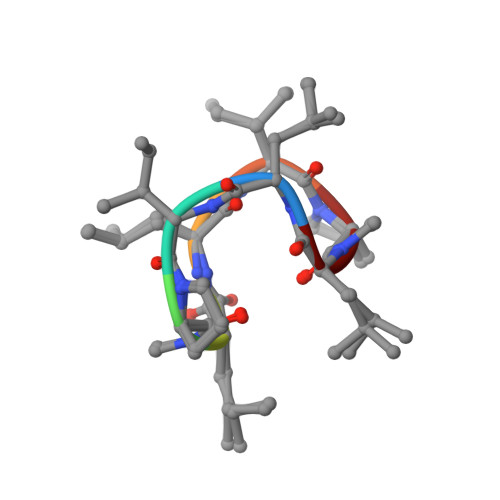Accurate de novo design of membrane-traversing macrocycles.
Bhardwaj, G., O'Connor, J., Rettie, S., Huang, Y.H., Ramelot, T.A., Mulligan, V.K., Alpkilic, G.G., Palmer, J., Bera, A.K., Bick, M.J., Di Piazza, M., Li, X., Hosseinzadeh, P., Craven, T.W., Tejero, R., Lauko, A., Choi, R., Glynn, C., Dong, L., Griffin, R., van Voorhis, W.C., Rodriguez, J., Stewart, L., Montelione, G.T., Craik, D., Baker, D.(2022) Cell 185: 3520-3532.e26
- PubMed: 36041435
- DOI: https://doi.org/10.1016/j.cell.2022.07.019
- Primary Citation of Related Structures:
7UBC, 7UBD, 7UBE, 7UBF, 7UBG, 7UBH, 7UBI, 7UCP, 7UZL, 8CTO, 8CUN, 8CWA - PubMed Abstract:
We use computational design coupled with experimental characterization to systematically investigate the design principles for macrocycle membrane permeability and oral bioavailability. We designed 184 6-12 residue macrocycles with a wide range of predicted structures containing noncanonical backbone modifications and experimentally determined structures of 35; 29 are very close to the computational models. With such control, we show that membrane permeability can be systematically achieved by ensuring all amide (NH) groups are engaged in internal hydrogen bonding interactions. 84 designs over the 6-12 residue size range cross membranes with an apparent permeability greater than 1 × 10 -6 cm/s. Designs with exposed NH groups can be made membrane permeable through the design of an alternative isoenergetic fully hydrogen-bonded state favored in the lipid membrane. The ability to robustly design membrane-permeable and orally bioavailable peptides with high structural accuracy should contribute to the next generation of designed macrocycle therapeutics.
- Institute for Protein Design, University of Washington, Seattle, WA 98195, USA; Department of Medicinal Chemistry, University of Washington, Seattle, WA 98195, USA; Biological Physics, Structure and Design program, University of Washington, Seattle, WA 98195, USA. Electronic address: gauravb@uw.edu.
Organizational Affiliation:

















